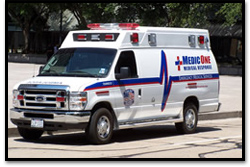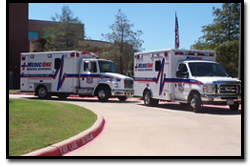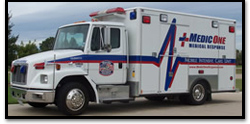
EMT's and Paramedics are well trained healthcare professionals whom respond to medical and traumatic emergencies in the pre-hospital setting. Although there is a vast difference between a Paramedic and an EMT, most people do not realize that there is a difference. This common misconception has been brought about due to movies, television and the news media, often confusing them at the same time.
 So what is the difference?
So what is the difference?The primary difference between a Paramedic and an EMT is the amount of education and their scope of practice (what they are allowed to do). Both are highly skilled at their respective professions; however they are not equal in the level of care that is provided.
Emergency Medical Technicians
EMT-Basics are often referred to as EMT's. EMT's are trained to provide basic-level life support to persons who are hurt or injured. EMT's can perform CPR, artificial ventilations, oxygen administration, basic airway management, spinal immobilization, vital signs and bandaging/splinting.
EMT training consists of 80 to 106 hours of classroom education plus 10 hours of internship and field training. EMT training is considered the entry level for Emergency Medical Services. EMT's may also receive an additional 250 hours of training to become an EMT-Intermediate. EMT-I's perform additional skills such as intravenous therapy and automated defibrillation.
 Paramedics
ParamedicsThe highest skilled pre-hospital provider is the Paramedic. Paramedics are licensed healthcare professionals who provide the most extensive pre-hospital advanced life support. Paramedics provide care that is on par with that of the emergency room. During a medical emergency Paramedics can provide advanced life support care including: advanced airway management, endotracheal intubation (breathing tube), manual defibrillation, external transcutaneous pacing, EKG monitoring, 12-lead EKG acquisition, IV fluid therapy, intraosseus infusions, hemodynamic monitoring, needle chest decompressions, surgical airways, administration of a wide array of critical care medications and mechanical ventilation.
Paramedics are required to complete 1100 hours of classroom training plus an additional 500 hours of internship and field training. Paramedic programs are college based, thus requiring pre-requisite college education in addition to basic EMT training. Additionally, Paramedics maintain specialty classifications once licensed, such as Advanced Cardiac Life Support, Pediatric Advanced Life Support, Neonatal Resuscitation Program, Pre-Hospital Trauma Life Support, Critical Care Paramedic and Certified Flight Paramedic to name a few.
 Critical Care Paramedics
Critical Care ParamedicsCritical Care Paramedics perform interfacility transports, moving very sick patients from one hospital to another for further care and treatment. Critical Care Paramedics have an expanded scope of practice allowing them to administer more medications than the normal Paramedic.
Critical Care Paramedics are trained in all common aspects of critical care assessment and management including pathophysiology, pharmacology, 12-lead ECG interpretation, interpretation of laboratory values, interpretation of routine diagnostic images, ventilator management, aortic balloon pump management, and air medical concepts.
 Currently there are two recognized credentialing bodies that certify Critical Care Paramedics.
Currently there are two recognized credentialing bodies that certify Critical Care Paramedics.
CCEMT-P: The University of Maryland, Baltimore County
CCP-C: The Board for Critical Care Transport Paramedic Certification
MedicOne requires that all employed Paramedics receive either Critical Care Paramedic certification within 18 months of hire. MedicOne has begun the process of providing the critical care education program in house.
MedicOne utilizes Paramedics and Critical Care Paramedics for emergency response and interfacility transports. That's why you should choose MedicOne!